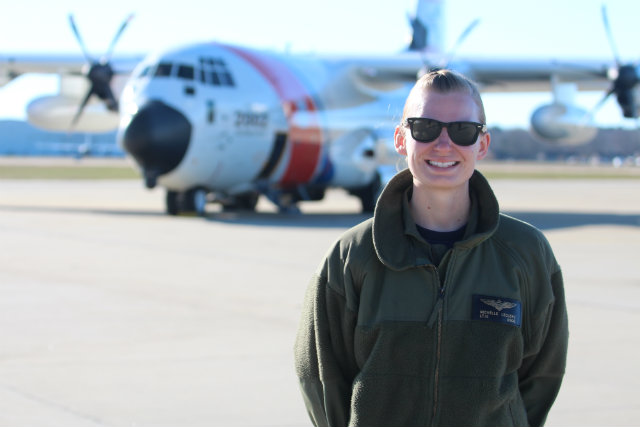Did you always want to fly?
When I was 11, I learned about the US Coast Guard (USCG) and thought it would be rewarding to fly Coast Guard planes and have a role in saving lives. I’m very fortunate that the dream I had as an 11 year old turned into reality. I graduated from the USCG Academy in 2012 with a degree in civil engineering. Upon receiving my degree and commission, I went directly to flight school in Pensacola, Florida. I began my flight training on a Piper Warrior, transitioned to the Beechcraft T-6B, and finished training on the T-44C in Corpus Christi, Texas.
I completed flight school in August 2014 and received orders to USCG Air Station Elizabeth City, North Carolina, to fly the HC-130J. I quickly began my training on this airframe and was fully qualified as a co-pilot in November 2014, only a few short months after receiving my wings.
What's next?
I am still in Elizabeth City and looking forward to possibly being stationed in Kodiak, Alaska, next. I am working towards my qualification as first pilot and on my way to becoming aircraft commander. As a C-130J pilot, my primary duty is being a fixed wing aviator, flying on USCG missions such as search and rescue, drug interdiction, and ice operations. I also have several collateral duties that help the unit administratively.

US Coast Guard
Where do your missions take you?
Air Station Elizabeth City’s area of responsibility ranges north towards Canada, east to the Azores, and as far south as the Caribbean. In addition to covering all USCG missions needing C-130J support in our area, we participate in International Ice Patrol out of St John’s, Newfoundland for half the year and drug interdiction missions based in various countries in Central America for the other half. I feel lucky that I’ve been exposed to so many different mission types in so many places in the little more than a year that I’ve been here.
Had any risky adventures?
I was selected to go to Lajes in the Azores, Portugal, for a search and rescue exercise in May 2015 that included Portugal, Canada, and the US. Before the exercise began one day, the Portuguese search and rescue co-ordinators asked my crew if we could assist with an actual rescue. A sailing vessel in 40ft seas was in distress 600 miles away with four people on board. We arrived on scene and discovered that the other aircraft had departed early due to reaching bingo fuel. With the aircraft gone, we had to the search for the distressed vessel. We were only able to reacquire the vessel after they shot off a flare. Moments later, we vectored in a Portuguese helicopter and provided cover as they hoisted the four survivors off the sailboat. Just when we thought our part was done, the helicopter, now with eight people on board between the crew and survivors, declared emergency fuel. My aircraft safely escorted the helicopter back to land by providing accurate wind readings at various altitudes to conserve fuel. Our crews celebrated together later that night where we learned that the helicopter landed with just 15min of usable fuel left.
What's the hardest part of your job?
The hardest part of my job is ensuring that I take time for myself away from the cockpit. Especially on longer deployments, I can start to lose sight of the things I have going on outside of the Coast Guard. Fortunately, my unit’s leadership supports all of us in focusing on both the demands from the air station and the demands from our personal lives. Other than flying, the most enjoyable part of my job is working with a variety of people. I love learning someone’s life story when we’re on a long mission in the middle of the night.
Source: Flight International
















